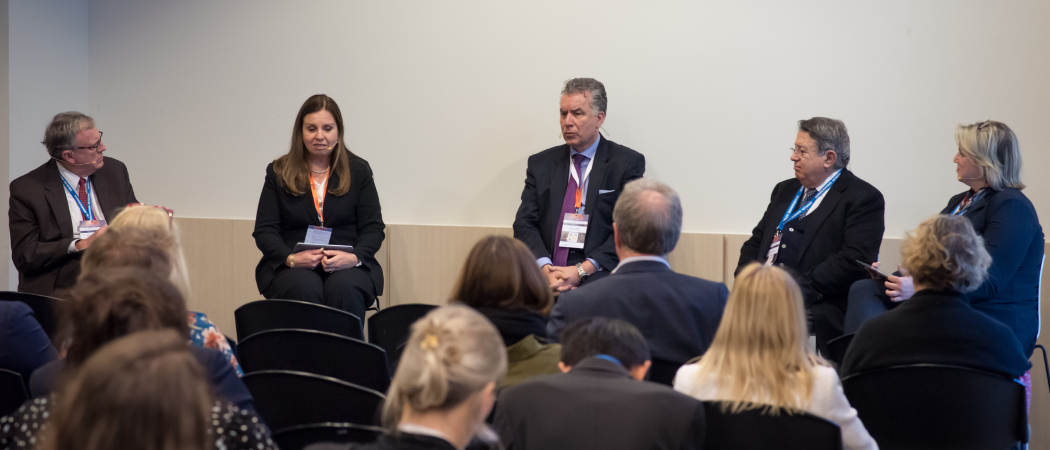They’re vital in translating research to market, but there is no common view of what technology infrastructures are. Christian Ehler MEP tells a Science|Business conference he wants the Commission to agree a definition as the basis of future policy

MEP Christian Ehler (Centre) spoke about the importance of defining technology infrastructures at a Science|Business conference in Brussels this week
The European Parliament wants the EU to define the term ‘technology infrastructure’ in order to lay the ground for the creation of a European ecosystem of these facilities.
“I am going to propose a pilot project for the autumn to define more precisely - and define in line with the question of how to fund - technology infrastructures,” Christian Ehler, one of the Parliament’s key voices in R&I policy, announced at the Science|Business annual conference, ‘Sustainable Horizons: Does our future depend on Science’ on Tuesday.
Unlike research infrastructures, no clear definition of technology infrastructure exists, and any facilities, equipment, services that facilitate technology transfer and development can earn the title. Typically, they provide resources to enable smaller companies to test out and scale up their innovations, and R&I proponents want them to be mapped out and organised to boost access and spur investment.
Industry has been calling on the EU to set clearer policy around technology infrastructures for the past few years, and with a push from the Parliament, there is finally some momentum.
Research infrastructures provide the exemplar here, with the EU having a strong framework for cooperation and an established permanent forum setting out what new facilities are needed for the future. Technology infrastructures have not received the same support, in part because there is no mapping or clear definition of what they are.
This has to change, Ehler believes. With the EU looking to propel two major economic and societal transitions, green and digital, a myriad of new technologies will have to be developed and products will have to get to market. For this, companies need the space to experiment and scale up.
“What we are going to see is that we simply need to invest in infrastructure, because if we want to deliver on 2030 [climate targets], we need a scale-up, a ramp up of the[se] technologies,” said Ehler.
Targeted investment
Even without a clear plan, the EU is investing in much-needed infrastructure, such as test beds, simulators and wind tunnels. Apostolia Karamali, head of unit for R&I Actors and Research Careers at the European Commission, says the Commission is on board with Ehler’s idea, as it is high time to identify what infrastructures are in place and what the gaps may be.
“We have been doing many things in practice but it’s high time we give this initiative an identity,” said Karamali. “We need to be able to decide where to target our investments and which areas need further development.”
Ehler hopes a clearer framework will also spur further investment, allowing member states to use structural funds, InvestEU and the EU’s €750 billion recovery package to fund technology infrastructures.
The time to act is now, Ehler believes, with the EU beginning discussions on revamping state aid rules to boost its net zero industry in response to the US Inflation Reduction Act, which is incentivizing European green tech companies to move there. He aims to get the Commission to launch the research infrastructures pilot this autumn, but first has to secure the backing of Parliament budget and industry, research and energy (ITRE) committees, to get the mandate to demand action from the Commission.
Not starting from scratch
Over the past few years, the Commission has been edging to consolidate policy on technology infrastructures. It’s one of the action areas in the European Research Area (ERA) framework that aims to create a single market for research, and there’s a new advisory group looking at defining pilot areas.
One of these, a pilot project on aeronautics has already mapped out industry’s needs, alongside the existing technology infrastructures that are relevant to the sector. Next up are discussions with member states on further investment under the Horizon Europe aviation partnership with industry.
The goal is to set up a cross-border ecosystem where companies could test prototypes and hone new technologies, much as scientists from across Europe can get access to research infrastructures to carry out their experiments.
A better ecosystem for tech infrastructure, many argue, is needed – to train staff, pilot new ideas and incubate spin-off companies. That kind of ecosystem already exists for traditional research infrastructure, said Sergio Bertolucci, former scientific director of high-energy physics lab CERN and currently a committee chair of ATTRACT, an EU-funded ecosystem project. But it’s easier to make that work in the research world, where people are accustomed to sharing information. In the commercial world of technology infrastructure, the need to protect intellectual property rights makes it more complicated.
With research infrastructure, Bertolucci said, it’s the ideas – wherever they arise – that matter. With tech infrastructure, “it essentially is not content (that matters) but who owns it.” Still, he said, Europe must figure out a way to make an ecosystem work for tech infrastructure; in that field, “there is an enormous repository of content, instrumentation, ideas, net worth, which is untapped for innovation.”
Universities and research organisations have expressed some scepticism about drawing a boundary between research and technology infrastructures, pointing to the fact that there is often no clear distinction between the two, with the former often open to industry.
But Ehler says that while the two may overlap, technology infrastructures have a clear purpose to support close-to-market innovation, and thus their mapping may not mirror research infrastructures but rather be sector and purpose-specific. “It’s more of a question of purpose than definition,” said Ehler.
Editor's note: this article was updated on 20 February to include comments from Sergio Bertolucci.





 A unique international forum for public research organisations and companies to connect their external engagement with strategic interests around their R&D system.
A unique international forum for public research organisations and companies to connect their external engagement with strategic interests around their R&D system.